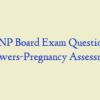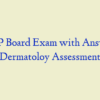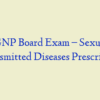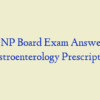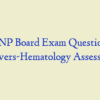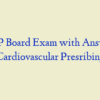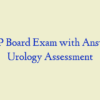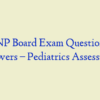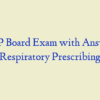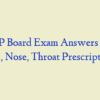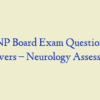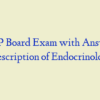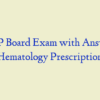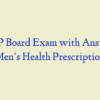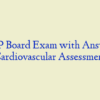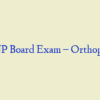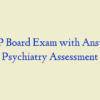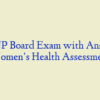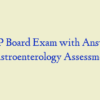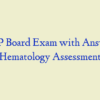Description
AGNP BOARD EXAM QUESTIONS Women’s Health Prescription (101 Questions)
- Which of the following is NOT a common side effect associated with the use of etonogestrel/ethinyl estradiol (NuvaRing), a contraceptive vaginal ring?
- A common side effect associated with the use of progestin-only contraceptives is:
- The drug of choice to control mild abnormal uterine bleeding in a 25-year-old woman with future childbearing plans is:
- Nonhormonal treatments for menopausal symptoms include:
- In the presence of mild hyperandrogenic symptoms related to polycystic ovarian syndrome (PCOS), the initial recommended treatment is:
- Which of the following medications would NOT be beneficial in the treatment of pain associated with fibrocystic breast disease?
- The copper component of the ParaGard intrauterine device to prevent pregnancy is thought to:
- The drug of choice to control mild abnormal uterine bleeding in a teenage patient is:
- A benefit associated with the use of medroxyprogesterone acetate (Depo-Provera), a progestin-only contraceptive, is:
- Progestin-only contraceptives:
- Late breakthrough bleeding or amenorrhea while taking an oral contraceptive may mean that the oral contraceptive has:
- In the prevention of pregnancy, medroxyprogesterone acetate (Depo-Provera) should be administered at least every:
- Tranexamic acid (Lysteda), used in the treatment of abnormal uterine bleeding, should not be administered concomitantly with:
- When treating hirsutism associated with polycystic ovarian syndrome, the best treatment is:
- Which of the following is NOT a steroidal progestin found in contraceptives?
- Danazol, classified as an androgen, is used in the treatment of abnormal uterine bleeding and endometriosis. It works by suppressing:
- Oral contraceptive regimens in which the estrogen and progestin both vary throughout the cycle are considered:
- Uncomplicated vulvovaginal candidiasis can effectively be treated with:
- Patients taking oral contraceptives do NOT need to use a back-up method of contraception if taking:
- Etonogestrel (Nexplanon) implant, used for contraception, is contraindicated in women:
- A woman who has had a hysterectomy complains of vaginal dryness, burning, and itching. A hormonal treatment is:
- In addition to inhibiting ovulation, combined contraceptives further prevent pregnancy by:
- If a patient is experiencing breast tenderness and hypertension, she may be taking an oral contraceptive with:
- When using an oral contraceptive patch, the patient should be advised:
- Which of the following medications is an aldosterone receptor antagonist and is used in the treatment of fibrocystic breast disease?
- ParaGard intrauterine device should be changed every:
- When treating acne associated with polycystic ovarian syndrome, the best initial treatment is:
- A common side effect of medroxyprogesterone acetate (Provera), a progesterone derivative, is:
- The contraceptive that would be most appropriate for a lactating woman is:
- Intrauterine devices for contraception:
- Medroxyprogesterone (Provera), used to provide contraception and manage abnormal uterine bleeding, does NOT exhibit:
- Etonogestrel (Nexplanon) implant for contraception:
- Combination estrogen and progesterone therapy:
- Fluconazole (Diflucan), an antifungal, should not be administered concomitantly with:
- The recommended treatment of recurrent vulvovaginal candidiasis is fluconazole administered:
- For treatment of menopausal symptoms in a woman with a history of hormone-sensitive breast cancer, the nurse practitioner should consider:
- Which of the following is NOT true about hormone replacement therapy (HRT) in menopause?
- A Bartholin’s gland abscess caused by Staphylococcal aureus infection is best treated with:
- Transdermal contraceptives, when compared to oral combined contraceptives,:
- A patient who is complaining of early or midcycle bleeding may need an oral contraceptive with:
- Which of the following would NOT be an appropriate choice for the treatment of primary dysmenorrhea in an 18-year-old woman?
- The brand name for medroxyprogesterone acetate, a progestin-only contraceptive, is:
- Spironolactone (Aldactone), used in the treatment of polycystic ovarian syndrome, is highly protein bound and has a duration of:
- A 23-year-old woman is receiving spironolactone (Aldactone) for premenstrual dysphoric disorder. At follow-up, she has a serum potassium of 5.8 mEq/L. The nurse practitioner should:
- The mechanism of action of levonorgestrel in the Mirena intrauterine device is to:
- Danazol is indicated in the treatment of:
- Etonogestrel (Nexplanon) implant for contraception contains:
- A 23-year-old woman complains of breakthrough bleeding 1 month after being started on a combination oral contraceptive (OC). The nurse practitioner should:
- Which statement is true about diaphragms in comparison to pharmacologic methods of contraception?
- Which medication is considered an estrogen for the control of abnormal uterine bleeding?
- Side effects of levonorgestrel (Plan B) to prevent pregnancy may include:
- A monophasic oral contraceptive:
- Medroxyprogesterone acetate (Provera) reduces abnormal uterine bleeding by:
- Buspirone (BuSpar), used in the treatment of anxiety related to premenstrual dysphoric disorder,:
- Fluconazole (Diflucan), an antifungal,:
- When using metformin (Glucophage) to restore ovulation/menses in polycystic ovary syndrome, full restoration may take up to:
- A 23-year-old woman with a desire for pregnancy needs treatment for symptoms related to polycystic ovarian syndrome (PCOS). The initial choice is:
- Combined contraceptive patches:
- Women who have had levonorgestrel (Mirena) implanted to prevent pregnancy do NOT need to immediately report:
- Medications that may be helpful in the treatment of vulvodynia include:
- Combined oral contraceptive use is absolutely contraindicated in patients who:
- Spironolactone (Aldactone), sometimes used to reduce the symptoms of hirsutism related to polycystic ovarian syndrome, is classified as a(n):
- Which medication is NOT the best first choice for the treatment of anxiety/mood disorders related to premenstrual dysphoric disorder?
- The brand name for fluconazole, an antifungal, is:
- The highest risk of deep vein thrombosis (DVT) is associated with combined estrogen and progesterone therapy that is administered via:
- Which of the following is true about missed doses of oral contraceptives?
- Etonogestrel/ethinyl estradiol (NuvaRing), a contraceptive vaginal ring,:
- Prior to major surgery with prolonged immobilization, combined contraceptives should be stopped at least:
- Combined oral contraceptives are NOT likely to cause:
- Topical creams and suppositories used in the treatment of vulvovaginal candidiasis:
- Patients who have been treated with danazol for abnormal uterine bleeding should be instructed that ovulation and cyclic bleeding should resume within:
- Combined contraceptives, whether oral, patch or intravaginal, work in the ovulatory phase by:
- A 18-year-old patient took levonorgestrel (Plan-B) 24 hours after unprotected sex. She calls the office and requests additional information. The provider should advise the patient:
- The best choice for short-term treatment of severe abnormal uterine bleeding is:
- Danazol, an androgen, may cause:
- Which of the following is NOT true about the administration of medroxyprogesterone acetate (Depo-Provera)?
- Oral contraceptives in which the estrogen remains consistent, but the progestin varies throughout the cycle, is considered:
- In oral contraceptives, when the estrogen dose remains the same for the first 21 days of the cycle and progestin is lower in the first half and higher in the second half, the regimen is classified as:
- Which of the following is NOT a mechanism of action for progestin-only contraceptives, also known as the “mini-pill”?
- Spermicides to prevent pregnancy:
- Serious adverse reactions of progesterone therapy that warrant immediate medical attention include:
- Before prescribing oral contraceptives, the nurse practitioner should check for:
- Potential side effects associated with the use of combined oral contraceptives are:
- The best treatment choice for polycystic ovarian syndrome in a 23-year-old woman with an intact uterus and history of migraine with aura is:
- When prescribing spironolactone for fibrocystic breast disease or polycystic ovarian syndrome, the nurse practitioner should provide initial and routine monitoring of:
- When a woman experiences weight gain, fatigue and changes in mood, her oral contraceptive may have too:
- The half-life of fluconazole (Diflucan) for the treatment of vulvovaginal candidiasis is approximately:
- Tranexamic acid (Lysteda), used in the treatment of abnormal uterine bleeding, is classified as a(n):
- Prior to the initiation of paroxetine (Paxil) to treat mood disorder related to premenstrual dysphoric disorder in an 18-year-old woman, the nurse practitioner should check for:
- Levonorgestrel (Plan B) for women who do not desire pregnancy:
- A 53-year-old woman with an intact uterus has been receiving monophasic ethinyl estradiol for the treatment of perimenopausal symptoms. Which one of the following statements is true?
- The first-line treatment for mixed somatic and behavior symptoms related to severe premenstrual syndrome (PMS) when pregnancy is desired is:
- Levonorgestrel, the active ingredient in Plan B for undesired pregnancy, is also found in:
- Progestin-only contraceptives are contraindicated in women:
- When initiating progestin-only contraceptives, women should be advised to:
- Intrauterine devices should NOT be implanted in women:
- Levonorgestrel (Plan B), an emergency contraceptive, is absolutely contraindicated:
- The brand name for spironolactone, used in the treatment of fibrocystic breast disease, is:
- The generic name of Diflucan is:
- An oral contraceptive known as the “mini-pill” contains:
- Levonorgestrel (Mirena) intrauterine device to prevent pregnancy should be changed every:


